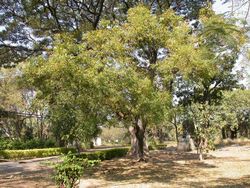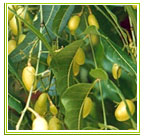
Azadirachta Indica (Neem)
Family Name : MELIACEAE
Botanical Name : AZADIRACHTA
INDICA
Common Name : LILAC, MARGOSA
TREE, NEEM, NEEM CHAL
Part Used : LEAVES, FLOWER,
OIL, SEED
Habitat : It is evergreen
and grows throughout India.
The neem tree is noted for
its drought resistance. Normally it thrives in areas with sub-arid to sub-humid
conditions, with an annual rainfall between 400 and 1200mm. It can grow
in regions with an annual rainfall below 400 mm, but in such cases it depends
largely on the ground water levels. Neem can grow in many differenttypes
of soil, but it thrives best on well drained deep and sandy soils (pH 6.2-7.0).
It is a typical tropical/subtropical tree and exists at annual mean temperaturesbetween
21-32 °C. It can tolerate high to very high temperatures. It does not
tolerate temperature below 4 °C (leaf shedding and death may ensue).
Uses : Vermifuge, Insecticide,
Astringent, Tonic and Antispetic. It posseses anti diabitic, anti bacterial
and anti viral properties and used sucessfully in cases of stomach, worms
and ulcers. Root bark posseses anstringent, tonic and antiperiodic properties.
It is also useful in Malarial fever. The oil is used in making Neem based
soaps, shampoos and toothpaste.
Uses in pest and disease
control Both polar extracts and neem oil are of primary interest to research
scientists as an insecticide. The active insecticidal ingredient, azadirachtin,
is also effective against mites and other arthropods. Many of the tree's
secondary metabolites have biological activity, but azadirachtin is considered
to be of the most ecological importance.
Studies have shown a wide
spectrum of activity and species affected. It acts by breaking the insect's
lifecycle. Research has increased in the past few years as the desire for
safer pest control methods increases and it becomes apparent that this
tree will be able to play a role in integrated pest management systems.
Because of its low toxicity , neem oil is available for general use in
most countries, and is permitted for restricted use under the National
Organic Program in the United States.
Other ingredients in neem
oil are also effective as fungicides.
Neem is deemed very effective
in the treatment of scabies although only preliminary scientific proof
exists which still has to be corroborated, and is recommended for those
who are sensitive to permethrin, a known insecticide which might be irritant.
Also, the scabies mite has yet to become resistant to neem, so in persistent
cases neem has been shown to be very effective. There is also anecdotal
evidence of its effectiveness in treating infestations of head lice in
humans.
















